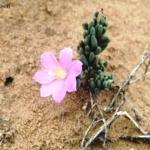Phemeranthus brachypodius (Laguna Fame Flower)
Talinum brachypodium S. Watson
| USFWS | State of NM | USFS | BLM | Navajo Nation | State Rank | Global Rank | R-E-D Code | NMRPTC Status | Strategy Status |
|---|---|---|---|---|---|---|---|---|---|
| S1 | GNRQ | 3-1-3 | R | SS |
| Overall Conservation Status | Documented Threats |
|---|---|
| WEAKLY CONSERVED | No information |
Small, succulent perennial herb; taproot thickened, tuberous, often branched; stems, tufted, few-branched, procumbent; leaves alternate, crowded on stem, nearly terete, usually blunt or obtuse apically, 1.5-2.5 cm long and 1.5-2.5 mm thick, light glaucous green; flowers borne singly (rarely in pairs) on short pedicels from leaf axils, mostly perfect, sometimes pistillate (usually both types on same plant), about 2-2.5 cm in diameter; sepals 2, foliaceous, deciduous in fruit; petals 5-8, lavender-pink (sometimes lighter or darker); stamens numerous; fruit a capsule, nearly globose, 3-valved dehiscing longitudinally and disintegrating at maturity; seeds roughly 1 mm in diameter, nearly discoid, often slightly concave on one or both sides, nearly smooth, black, covered by a thin translucent aril (pellicle) which imparts a grayish or slightly bluish appearance. Flowers June to August.
The more widespread Phemeranthus brevicaulis (= Talinum eximium, T. pulchellum, and T. youngii) is often sympatric and may be distinguished by the more acute leaf tips, flowers born in short indeterminate axillary cymes, sepals acute and persistent in fruit, more pointed petals, and narrower and more pointed fruits. Phemeranthus brevifolius is very similar to P. brachypodius; however, it occurs further to the west (closest known populations are northeast of Gallup, New Mexico). It is separable by its smaller size (averaging about 1/2 to 2/3 the size of P. brachypodius in all proportions), and by its preference for substrates of fine-grained non-calcareous iron rich red sandstone of the "Rimrock Country" of the Colorado Plateau.
New Mexico, eastern Cibola, western Valencia, and northern Socorro counties.
Very shallow pockets of calcareous silt to clay soils overlying limestone or travertine, or fine silty sand overlying calcareous sandstones; open piñon-juniper woodland with little understory and scattered cacti and shrubs or Chihuahuan desert scrub.
Phemeranthus brachypodius is closely akin to Phemeranthus brevifolius and has been synonymized under it in Flora of North America, Volume 4 (2003); however, the two are recognizably distinct. Specimens identified as P. brevifolius from Valencia, Socorro, and perhaps some from Cibola counties are actually P. brachypodius. Some records for both names could be misidentified specimens of P. brevicaulis as well, which grows sympatrically with P. brachypodius at all (basically two) known locations for the later. P. brachypodius is also in se. Cibola County (Laguna Pueblo area). It has been poorly documented in herbaria and field surveys, but se. Cibola to north central Socorro is likely the full distribution.
This is a very ornamental species that has caught the eye of a few rock garden plant nurseries. It is apparently restricted to a narrow belt of calcareous habitats in central New Mexico, but further search may extend its known distribution.
It is cultivated for commercial purposes on a small scale, but it is easily propagated so collecting is little or no threat. It is negatively impacted in some habitats by mining operations for travertine and limestone, but to date these operations have had little affect on the overall population. Domestic grazing pressure is often heavy in areas where this species is found and plants are often eaten, but this appears to have little lasting affect on populations, which seem to reproduce abundantly in recently grazed sites.
Ferguson, David J. 2020. New combinations in Montiaceae and Talinaceae. Cactus and Succulent Journal, Vol. 92 No.3, pp 236-247.
For distribution maps and more information, visit Natural Heritage New Mexico




